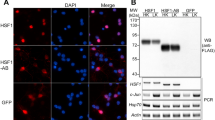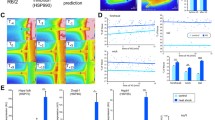Summary
Following stress such as heat shock or transient cerebral ischemia, global brain protein synthesis initiation is depressed through modulation of eucaryotic initiation factor (eIF) activities, and modification of ribosomal subunits. Concomitantly, expression of a certain class of mRNA, heat-shock protein (HSP) mRNA, is induced. Here we report that the activity of eucaryotic initiation factor-2 (eIF-2), a protein that participates in the regulation of a rate-limiting initiation step of protein synthesis, transiently decreases following insulin-induced severe hypoglycemia in the rat brain neocortex. Expression of HSP 72, a 72-kDa HSP, in surviving neurons was seen at 1–7 days of recovery following 30 min of hypoglycemic coma, but not at 1 h and 6 h of recovery. In the neocortex, HSP 72 was first seen in layer IV, and later also in surviving neurons in layer II. In the CA1 region and in the crest of dentate gyrus, HSP 72 expression was evident in cells adjacent to irreversibly damaged neurons. In the CA3 region and the hilus of dentate gyrus, HSP 72 was expressed in a few scattered neurons. In septal nucleus, HSP 72 was expressed in a lateral to medial fashion over a period of 1–3 days of recovery. We conclude that severe insulin-induced hypoglycemia induces a stress response in neurons in the recovery phase, including inhibition of protein synthesis initiation, depression of eIF-2 activity, and a delayed and prolonged expression of HSP 72 in surviving neurons. The HSP 72 expression may be a protective response to injurious stress.
Similar content being viewed by others
References
Agardh C-D, Folbergrová J, Siesjö B (1978) Cerebral metabolic changes in profound, insulin-induced hypoglycemia, and in the recovery period following glucose administration. J Neurochem 31:1135–1142
Auer R (1986) Progressive review: hypoglycemic brain damage. Stroke 17:699–708
Auer R, Siesjö B (1988) Biological differences between ischemia, hypoglycemia and epilepsi. Ann Neurol 24:699–707
Auer R, Wieloch T, Olsson Y, Siesjö B (1984) The distribution of hypoglycemic brain damage. Acta Neuropathol (Berl) 64:117–191
Auer RN, Olsson Y, Siesjö BK (1984) Hypoglycemic brain injury in the rat. Correlation of density of brain damage with the EEG isoelectric time: a quantitative study. Diabetes 33:1090–1098
Barbe M, Tytell M, Gower D, Welch W (1988) Hyperthermia protects against light damage in the rat retina. Science 241:1817–1820
Benjamin I, Krüger B, Williams R (1990) Activation of the heat shock transcription factor by hypoxia in mammalian cells. Proc Natl Acad Sci USA 87:623–6267
Chopp M, Li Y, Dereski M, Levine S, Yoshida Y, Garcia J (1992) Hypothermia reduces 72-kDa heat shock protein induction in rat brain after transient forebrain ischemia. Stroke 23:104–107
Cooper HK, Zalewska T, Kawakami S, Hossmann K-A, Kleihues P (1977) The effect of ischemia and recirculation on protein synthesis in the rat brain. J Neurochem 28:929–934
Deshpande J, Bergstedt K, Lindén T, Kalimo H, Wieloch T (1992) Ultrastructural changes in the hippocampal CA1 region following transient cerebral ischemia. Evidence against programmed cell death. Exp Brain Res 88:91–105
Duncan R, Hershey J (1984) Heat shock-induced translational alterations in HeLa cells. J Biol Chem 259:11882–11889
Duncan R, Hershey J (1987) Translational repression by chemical inducers of the stress response occurs by different pathways. Arch Biochem Biophys 256:651–661
Finley D, Varshavsky A (1985) The ubiquitin system: functionss and mechanisms. Trends Biochem Sci 9:343–346
Gonzalez M, Lowenstein D, Fernyak S, Hisanaga K, Simon R, Sharp F (1991) Induction of heat shock protein 72-like immunoreactivity in the hippocampal formation following transient global ischemia. Brain Res Bull 26:241–250
Hershey JWB (1991) Translation control in mammalian cells. Annu Rev Biochem 60:717–755
Hu B-R, Wieloch T (1993) Stress induced inhibition of protein synthesis initiation. Modulation of initiation factor-2 and guanine nucleotide exchange factor activities following transient cerebral ischemia in the rat. J Neurosci (in press)
Kalimo H, Agardh C-D, Olsson Y, Siesjö B (1980) Hypoglycemic brain injury. II. Electron microscopic findings in the rat cerebral cortical neurons during profound insulin-induced hypoglycemia and in the recovery period following glucose administration. Acta Neuropathol (Berl) 50:43–52
Kiessling M, Weigel K, Gartzen D, Kleihues P (1982) Regional hetorogeneity of L-[3-3H] tyrosine incorporation into rat brain proteins during severe hypoglycemia. J Cereb Blood Flow Metab 2:249–253
Kiessling M, Xie Y, Kleihues P (1984) Regionally selective inhibition of cerebral protein synthesis in the rat during hypoglycemia and recovery. J Neurochem 43:1507–1514
Kiessling M, Auer R, Kleihues P, Siesjö B (1986) Cerebral protein synthesis during long-term recovery from severe hypoglycemia. J Cereb Blood Flow Metab 6:42–51
Kirino T, Tsujity Y, Tamura A (1991) Induced tolerance to ischemia in gerbil hippocampal neurons. J Cereb Blood Flow Metab 11:299–307
Laemmli UK (1970) Cleavage of structural proteins during the assembly of the head of bacteriophage T4. Nature 227:680–685
Lindquist S, Craig E (1988) The heat shock proteins. Annu Rev Genet 22:631–677
Lowry O, Rosebrough N, Farr A, Randall R (1951) Protein measurement with Folin reagent. J Biol Chem. 193:265–275
Morley S, Thomas G (1991) Intracellular messengers and the control of protein synthesis. Pharmacol Ther 50:291–319
Nellgård B, Wieloch T (1992) Cerebral protection by AMPA-and NMDA-receptor antagonists administered after severe insulin-induced hypoglycemia. Exp Brain Res 92:259–266
Nowak T (1985) Synthesis of a stress protein following transient ischemia in the gerbil. J Neurochem 45:1635–1641
Nowak T (1990) Protein synthesis and the heat shock/stress response after ischemia. Cerebrovasc Brain Metab Rev 2:345–366
Nowak T (1991) Localization of 70 kDa stress protein mRNA induction in gerbil brain after ischemia. J Cereb Blood Flow Metab 11:432–439
Panniers R, Henshaw E (1983) A GDP/GTP exchange factor essential for eucaryotic initiation factor 2 recycling in Erlich ascites tumor cells and its regulation by eucaryotic initiation factor 2 phosphorylation. J Biol Chem 258:7928–7934
Petito C, Pulsinelli W (1984) Delayed neuronal recovery and neuronal death in the rat hippocampus following severe cerebral ischemia: possible relationship to abnormalities in neuronal processes. J Cereb Blood Flow Metab 4:194–205
Pontén U, Ratcheson R, Salford L, Siesjö B (1973) Optimal freezing conditions for cerebral metabolites in rats. J Neurochem 21:1127–1138
Price B, Calderwood S (1991) Ca2+ is essential for multistep actination of heat shock factor in permeabilized cells. Mol Cell Biol 11:3365–3368
Rausell E, Avendano C (1985) Thalamocortical neurons projecting to superficial and to deep layers in parietal, frontal and prefrontal regions in the cat. Brain Res 347:159–165
Simon R, Hiroyuki C, Gwinn R, Lowenstein D (1991) The temporal profile of 72-kDa heat-shock protein expression following global ischemia. J Neurosci 11:881–889
Sloviter R, Lowenstein D (1992) Heat shock protein expression in vulnerable cells of the rat hippocampus as an indicator of excitation-induced neuronal stress. J Neurosci 12:3004–3009
Smith K, Henshaw E (1975) Binding of Met-tRNAf, to native and derived 40S ribosomal subunits. Biochemistry 14:1060–1067
Storm-Mathisen J (1981) Glutamate in hippocampal pathways. In: di Chiara G, Gessa G (eds) Glutamate as a neurotransmitter. Raven Press, New York, pp 43–55
Subjeck J, Shyy T-T (1986) Stress protein systems in the mammalian cells. Am J Physiol 250:C1-C17
Towbin H, Staehelin T, Gordon J (1979) Electrophoretic transfer of proteins from polyacrylamide gels to nitrocellulose sheets. Procedure and some applications. Proc Natl Acad Sci USA 76:4350–4354
Ulovec Z, Narancsik P, Gamulin S (1985) Effects of hypoglycemia on rat brain polyribosome sedimentation pattern. J Neurochem 45:352–355
Vass K, Berger M, Nowak TJ, Welch W, Lassmann H (1989) Induction of stress protein HSP70 in nerve cells after status epilepticus in the rat. Neurosci Lett 100:259–264
Widmann R, Kuriowa T, Bonnekoh P, Hossmann K-A (1991) [14C] Leucine incorporation into brain proteins in gerbils after transient ischemia: relationship to selective vulnerability of hippocampus. J Neurochem 56:789–796
Wieloch T (1985) Hypoglycemia induced neuronal damage prevented by N-methyl-D-aspartate antagonist. Science 230:681–668
Wong S, Mastropaolo W, Henshaw E (1982) Differential phosphorylation of soluble versus ribosome-bound eucaryotic initiation factor 2 in the Ehrlich ascites tumor cell. J Biol Chem. 257:5231–5238
Yee W, Frim D, Isacson O (1993) Temporal and spatial distribution of stress protein induction preceding NMDA-mediated neuronal death in the entorhinal cortex. Exp Brain Res (in press)
Author information
Authors and Affiliations
Rights and permissions
About this article
Cite this article
Bergstedt, K., Hu, BR. & Wieloch, T. Initiation of protein synthesis and heat-shock protein-72 expression in the rat brain following severe insulin-induced hypoglycemia. Acta Neuropathol 86, 145–153 (1993). https://doi.org/10.1007/BF00334881
Received:
Revised:
Accepted:
Issue Date:
DOI: https://doi.org/10.1007/BF00334881




